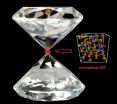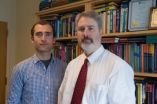(Press-News.org) An optical switch developed at the Joint Quantum Institute (JQI) spurs the prospective integration of photonics and electronics. What, isn't electronics good enough? Well, nothing travels faster than light, and in the effort to speed up the processing and transmission of information, the combined use of light parcels (photons) along with electricity parcels (electrons) is desirable for developing a workable opto-electronic protocol.
The JQI (*) switch can steer a beam of light from one direction to another in only 120 picoseconds (120 trillionths of a second), requiring very little power, only about 90 attojoules (90 x 10-18 joules). At the wavelength used, in the near infrared (921 nm), this amounts to about 140 photons. These new results are being published in an upcoming issue of the journal Physical Review Letters (**).
The centerpiece of most electronic gear is the transistor, a solid-state component in which a gate signal is applied to a nearby tiny conducting pathway, thus switching on and off the passage of an information signal. The analogous process in photonics would be a solid-state component which acts as a gate, enabling or disabling the passage of light through a nearby waveguide, or as a router, for switching beams in different directions.
In the JQI experiment, prepared and conducted at the University of Maryland and at the National Institute for Standards and Technology (NIST) by Edo Waks and his colleagues, an all-optical switch has been created using a quantum dot (the equivalent of a gate) placed inside a resonant cavity. The dot, consisting of a nm-sized sandwich of the elements indium and arsenic, is so tiny that electrons moving inside can emit light at only discrete wavelengths, as if the dot were an atom. The quantum dot sits inside a photonic crystal, a material that has been bored with many tiny holes. The holes preclude the passage of light through the crystal except for a narrow wavelength range.
Actually, the dot sits inside a small hole-free arcade which acts like a resonant cavity. When light travels down the nearby waveguide some of it makes its way into the cavity, where it interacts with the quantum dot. And it is this interaction which can transform the waveguide's transmission properties. Although 140 photons are needed in the waveguide to produce switching action, only about 6 photons actually are needed to bring about modulation of the QD, thus throwing the switch.
Previous optical switches have been able to work only by using bulky nonlinear-crystals and high input power. The JQI switch, by contrast, achieves high-nonlinear interactions using a single quantum dot and very low power input. Switching required only 90 aJ of power, some five times less than the best previous reported device made at labs in Japan (***), which itself used 100 times less power than other all-optical switches. The Japanese switch, however, has the advantage of operating at room temperature, while the JQI switch requires a temperature of around 40 K.
Continuing our analogy with electronics: light traveling down the waveguide (the equivalent of the conducting pathway in a transistor) in the form of an information-carrying (probe) beam can be switched from one direction to another using the presence of a second pulse, a control (pump) beam. To steer the probe beam out the side of the device, the slightly detuned pump beam needs to arrive simultaneously with the probe beam, which is on resonance with the dot. The dot lies just off the center track of the waveguide, inside the cavity. The temperature of the quantum dot is tuned to be resonant with the cavity, resulting in strong coupling. If the pump beam does not arrive at the same time as the probe, the probe beam will exit in another direction
So, is this quantum-dot switch an "optical transistor"? Not quite, says JQI scientist Ranojoy Bose. "Our waveguide-dot setup can't yet be used to modulate a beam of light using only a weak control pulse of light---what we would call a low-photon-number pulse.
But Bose says he expects an improvement (reduction) in the number of photons needed to switch the resonant cavity on and off. In the meantime, the JQI switch represents a great start toward creating a usable ultrafast, low-energy on-chip signal router. "Our paper shows that switching can be achieved physically by using only 6 photons of energy, which is completely unprecedented. This is the achievement of fundamental physical milestones—sub-100-aJ switching and switching near the single photon level," Bose says.
INFORMATION:
(*)The Joint Quantum Institute is operated jointly by the National Institute of Standards and Technology in Gaithersburg, MD and the University of Maryland in College Park.
(**) "Low photon number optical switching with a single quantum dot coupled to a photonic crystal cavity,"
Deepak Sridharan, Ranojoy Bose, Hyochul Kim, Glenn S. Solomon, and Edo Waks. Physical Review Letters, in press.
(***) Nozaki et al., Nature Photonics, 2 May 2010.
Ranojoy Bose, rbose@umd.edu, 301-405-0030
A copy of the PRL paper can be obtained from Phillip F. Schewe, pschewe@umd.edu, 301-405-0989. http://jqi.umd.edu/
Fast, low-power, all-optical switch
Switching light with light: only 140 photons are needed
2012-05-04
ELSE PRESS RELEASES FROM THIS DATE:
funK shades Expands Children's Sunglass Line With New Shades & Bright Spring Colors
2012-05-04
funK shades, the first makers of polarized children's sunglasses with snap-on charms, is bringing vivid spring colors and fashion-forward new styles to their Spring/Summer collection. With everything from chic neon pinks to breezy ocean blues, funK shades are 100% UVA UVB polarized lenses protecting children's eyes from harmful UV rays with both style and funKtion.
Just in time for summer, funK shades have added fashionable flair to its already adorable line of children's sunglasses. The new folding Wayfarer inspired frames are portable, compact, and perfect to endure ...
Scientists core into California's Clear Lake to explore past climate change
2012-05-04
University of California, Berkeley, scientists are drilling into ancient sediments at the bottom of Northern California's Clear Lake for clues that could help them better predict how today's plants and animals will adapt to climate change and increasing population.
The lake sediments are among the world's oldest, containing records of biological change stretching back as far as 500,000 years.
The core drilling is part of a unique, multifaceted effort at UC Berkeley to determine how Earth's flora and fauna responded to past changes in climate in order to improve models ...
Blacks and Hispanics at higher risk for precancerous colorectal polyps
2012-05-04
New York, NY (May 3, 2012) — Blacks and Hispanics have a significantly higher risk of developing precancerous colorectal polyps compared with whites, according to a study by researchers at NewYork – Presbyterian Hospital/Columbia University Medical Center. The findings appeared in the online edition of Alimentary Pharmacology and Therapeutics.
"Our data suggest that we need to redouble our efforts to increase colon cancer screening in areas with large numbers of racial and ethnic minorities," said lead author Benjamin Lebwohl, MD, MS, assistant professor of clinical medicine ...
New UF study shows early North Americans lived with extinct giant beasts
2012-05-04
New York, NY (May 3, 2012) — Blacks and Hispanics have a significantly higher risk of developing precancerous colorectal polyps compared with whites, according to a study by researchers at NewYork – Presbyterian Hospital/Columbia University Medical Center. The findings appeared in the online edition of Alimentary Pharmacology and Therapeutics.
"Our data suggest that we need to redouble our efforts to increase colon cancer screening in areas with large numbers of racial and ethnic minorities," said lead author Benjamin Lebwohl, MD, MS, assistant professor of clinical medicine ...
Thanks for the memory: More room for data in 'phase-change' material
2012-05-04
A team led by Johns Hopkins engineers has discovered some previously unknown properties of a common memory material, paving the way for development of new forms of memory drives, movie discs and computer systems that retain data more quickly, last longer and allow far more capacity than current data storage media.
The work was reported April 16 in the online edition of Proceedings of the National Academy of Sciences.
The research focused on an inexpensive phase-change memory alloy composed of germanium, antimony and tellurium, called GST for short. The material is already ...
What Big Skin Care Companies Don't Want You to Know
2012-05-04
If you are one of the millions of Americans suffering from the pain of dry cracked skin, chances are you've searched the aisles of your local drug store for a cure only to be disappointed by product after product. And most likely you've invested hundreds of dollars over the years on lotions that just end up sitting on your bathroom shelves or in the trash.
You are not alone.
Wonder ingredients that go nowhere:
The skin care industry is a multi-billion dollar industry with companies racing to create the newest wonder ingredients and fight for top celebrity endorsements ...
Geisel researchers sift through 'junk' to find colorectal cancer clues
2012-05-04
Two researchers at the Geisel School of Medicine at Dartmouth have helped to identify switches that can turn on or off genes associated with colorectal cancer. The finding offers clues about the development of colorectal cancer and could—potentially—provide targets for new therapies. Jason Moore, Third Century Professor of genetics and the director of the Institute for Quantitative Biomedical Sciences, and Richard Cowper-Sal.lari, a graduate student in Moore's lab, were part of a team that included researchers from Case Western Reserve University and the Cleveland Clinic. ...
Rob DeVincent of Corcentric to Co-host The Children's Place Procure-to-Pay Case Study Session at IOFO's Fusion 2012
2012-05-04
Corcentric, a leading provider of Accounts Payable automation solutions, today announced Rob DeVincent will be co-hosting an educational session at the Institute of Financial Operations' 2012 Fusion Conference, the largest conference for AP professionals and professionals working in all areas of financial operations. The session titled "The Retail Advantage: Case Study on P2P Automation at The Children's Place," is session #1710 in the AP, P2P, and TAWPI focus disciplines. This session, which offers one Business Management and Organization credit to attendees, ...
RealMoneyCasino.net States: 888 Holdings' Growth Likely to Continue
2012-05-04
Compared to the Q1 results of 2011, in which revenue was $75 million, the results for Q2 of 2012 is high at $94 million.
One of the key factors that played a role in this rise was an increase in the number of players who signed up at 888 Holdings' sites. On March 31, 2012, the number of customers at 888's sites was close to 11.5 million. The number of players active at 888 Holdings' sites was 566,000 in the first three months of March 2012, which is a rise of 87% compared to the same point last year.
According to a spokesperson for RealMoneyCasino.net, this is a ...
Rapid Sierra Nevada uplift tracked by scientists at the University of Nevada, Reno
2012-05-04
RENO, Nev. – From the highest peak in the continental United States, Mt. Whitney at 14,000 feet in elevation, to the 10,000-foot-peaks near Lake Tahoe, scientific evidence from the University of Nevada, Reno shows the entire Sierra Nevada mountain range is rising at the relatively fast rate of 1 to 2 millimeters every year.
"The exciting thing is we can watch the range growing in real time," University of Nevada, Reno's Bill Hammond, lead researcher on the multi-year project to track the rising range, said. "Using data back to before 2000 we can see it with accuracy better ...
LAST 30 PRESS RELEASES:
Numbers in our sights affect how we perceive space
SIMJ announces global collaborative book project in commemoration of its 75th anniversary
Air pollution exposure and birth weight
Obstructive sleep apnea risk and mental health conditions among older adults
How talking slows eye movements behind the wheel
The Ceramic Society of Japan’s Oxoate Ceramics Research Association launches new international book project
Heart-brain connection: international study reveals the role of the vagus nerve in keeping the heart young
Researchers identify Rb1 as a predictive biomarker for a new therapeutic strategy in some breast cancers
Survey reveals ethical gaps slowing AI adoption in pediatric surgery
Stimulant ADHD medications work differently than thought
AI overestimates how smart people are, according to HSE economists
HSE researchers create genome-wide map of quadruplexes
Scientists boost cell "powerhouses" to burn more calories
Automatic label checking: The missing step in making reliable medical AI
Low daily alcohol intake linked to 50% heightened mouth cancer risk in India
American Meteorological Society announces Rick Spinrad as 2026 President-Elect
Biomass-based carbon capture spotlighted in newly released global climate webinar recording
Illuminating invisible nano pollutants: advanced bioimaging tracks the full journey of emerging nanoscale contaminants in living systems
How does age affect recovery from spinal cord injury?
Novel AI tool offers prognosis for patients with head and neck cancer
Fathers’ microplastic exposure tied to their children’s metabolic problems
Research validates laboratory model for studying high-grade serous ovarian cancer
SIR 2026 delivers transformative breakthroughs in minimally invasive medicine to improve patient care
Stem Cell Reports most downloaded papers of 2025 highlight the breadth and impact of stem cell research
Oxford-led study estimates NHS spends around 3% of its primary and secondary care budget on the health impacts of heat and cold in England
A researcher’s long quest leads to a smart composite breakthrough
Urban wild bees act as “microbial sensors” of city health.
New study finds where you live affects recovery after a hip fracture
Forecasting the impact of fully automated vehicle adoption on US road traffic injuries
Alcohol-related hospitalizations from 2016 to 2022
[Press-News.org] Fast, low-power, all-optical switchSwitching light with light: only 140 photons are needed



